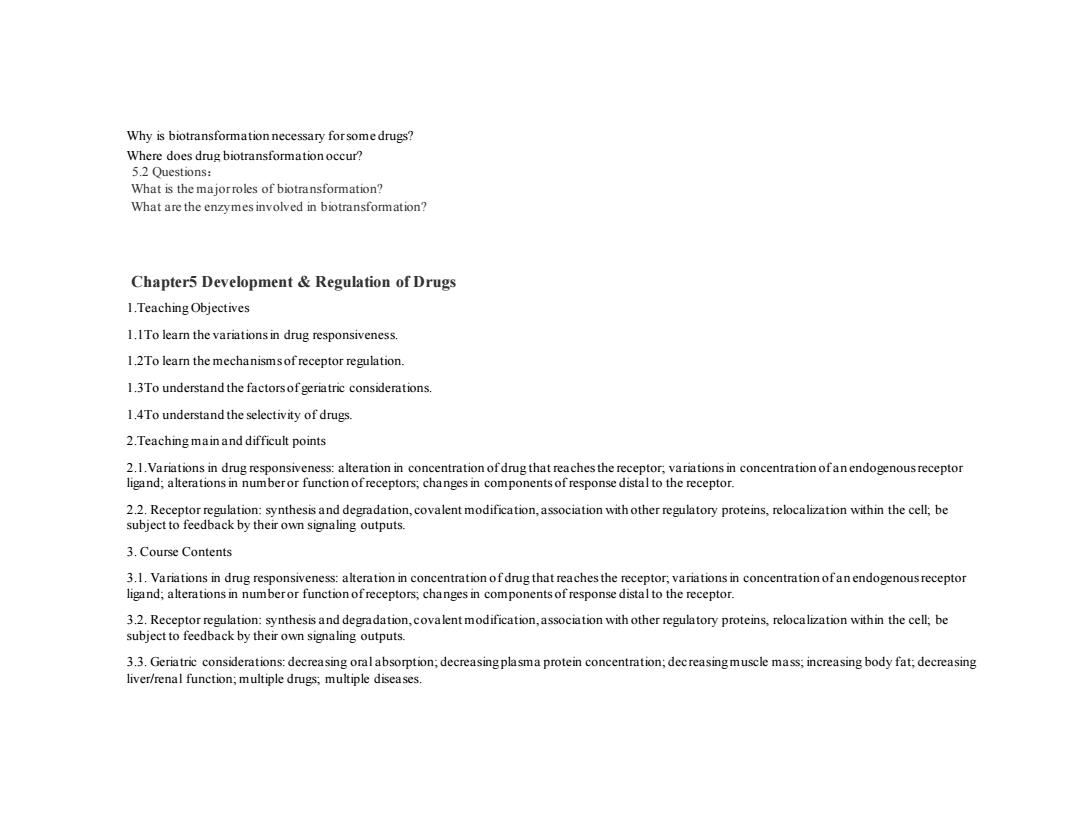
Why is biotransformation necessary forsome drugs? Where does drug biotransformation occur? 5.2 Questions: What is the majorroles of biotransformation? What are the enzymes involved in biotransformation? Chapter5 Development Regulation of Drugs 1.Teaching Objectives 1.ITo learn the variations in drug responsiveness. 1.2To learn the mechanismsof receptor regulation. 1.3To understand the factors of geriatric considerations. 1.4To understand the selectivity of drugs. 2.Teaching main and difficult points 2.1.Variations in drug responsiveness:alteration in concentration ofdrug that reaches the receptor,variations in concentration ofan endogenous receptor ligand;alterations in numberor function ofreceptors,changes in components of response distal to the receptor. 2.2.Receptor regulation:synthesis and degradation,covalent modification,association with other regulatory proteins,relocalization within the cell;be subject to feedback by their own signaling outputs. 3.Course Contents 3.1.Variations in drug responsiveness:alteration in concentration ofdrug that reaches the receptor,variations in concentration ofan endogenousreceptor ligand;alterations in numberor function ofreceptors;changes in components of response distal to the receptor. 3.2.Receptor regulation:synthesis and degradation,covalent modification,association with other regulatory proteins,relocalization within the cell;be subject to feedback by their own signaling outputs. 3.3.Geriatric considerations:decreasing oral absorption;decreasing plasma protein concentration;decreasing muscle mass;increasing body fat;decreasing liver/renal function;multiple drugs,multiple diseases
Why is biotransformation necessary for some drugs? Where does drug biotransformation occur? 5.2 Questions: What is the major roles of biotransformation? What are the enzymes involved in biotransformation? Chapter5 Development & Regulation of Drugs 1.Teaching Objectives 1.1To learn the variations in drug responsiveness. 1.2To learn the mechanisms of receptor regulation. 1.3To understand the factors of geriatric considerations. 1.4To understand the selectivity of drugs. 2.Teaching main and difficult points 2.1.Variations in drug responsiveness: alteration in concentration of drug that reaches the receptor; variations in concentration of an endogenous receptor ligand; alterations in number or function of receptors; changes in components of response distal to the receptor. 2.2. Receptor regulation: synthesis and degradation, covalent modification, association with other regulatory proteins, relocalization within the cell; be subject to feedback by their own signaling outputs. 3. Course Contents 3.1. Variations in drug responsiveness: alteration in concentration of drug that reaches the receptor; variations in concentration of an endogenous receptor ligand; alterations in number or function of receptors; changes in components of response distal to the receptor. 3.2. Receptor regulation: synthesis and degradation, covalent modification, association with other regulatory proteins, relocalization within the cell; be subject to feedback by their own signaling outputs. 3.3. Geriatric considerations: decreasing oral absorption; decreasing plasma protein concentration; dec reasing muscle mass; increasing body fat; decreasing liver/renal function; multiple drugs; multiple diseases
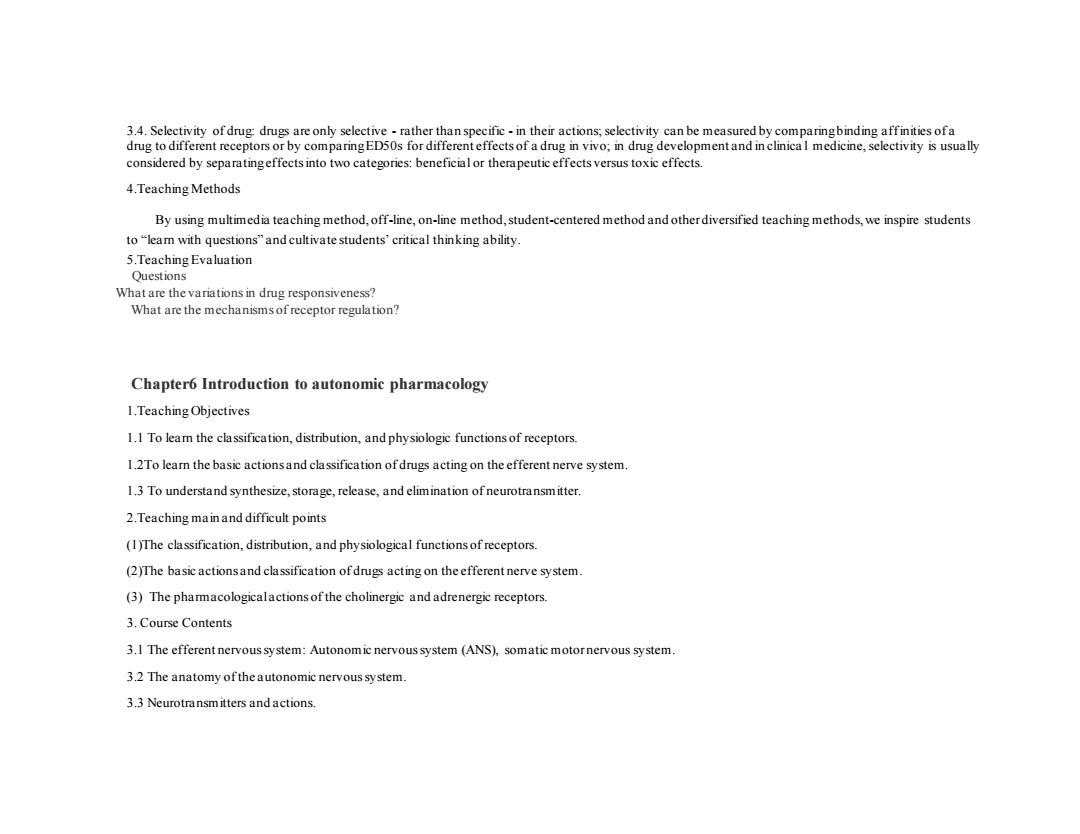
3.4.Selectivity of drug drugs are only selective-rather than specific-in their actions;selectivity can be measured by comparingbinding affinities ofa drug to different receptors or by comparingED50s for different effects of a drug in vivo;in drug development and in clinica l medicine,selectivity is usually considered by separatingeffects into two categories:beneficial or therapeutic effects versus toxic effects. 4.Teaching Methods By using multimedia teaching method,off-line,on-line method,student-centered method and other diversified teaching methods,we inspire students to"leam with questions"and cultivate students'critical thinking ability. 5.Teaching Evaluation Questions What are the variations in drug responsiveness? What are the mechanisms of receptor regulation? Chapter6 Introduction to autonomic pharmacology 1.Teaching Objectives 1.1 To leam the classification,distribution,and physiologic functions of receptors. 1.2To learn the basic actionsand classification ofdrugs acting on the efferent nerve system. 1.3 To understand synthesize,storage,release,and elimination of neurotransmitter. 2.Teaching main and difficult points (1)The classification,distribution,and physiological functions ofreceptors. (2)The basic actionsand classification of drugs acting on the efferent nerve system (3)The pharmacologicalactions of the cholinergic and adrenergic receptors. 3.Course Contents 3.1 The efferent nervous system:Autonomic nervous system (ANS),somatic motornervous system. 3.2 The anatomy ofthe autonomic nervous system. 3.3 Neurotransmitters and actions
3.4. Selectivity of drug: drugs are only selective - rather than specific - in their actions; selectivity can be measured by comparing binding affinities of a drug to different receptors or by comparing ED50s for different effects of a drug in vivo; in drug development and in clinica l medicine, selectivity is usually considered by separating effects into two categories: beneficial or therapeutic eff ects versus toxic effects. 4.Teaching Methods By using multimedia teaching method, off-line, on-line method, student-centered method and other diversified teaching methods, we inspire students to “learn with questions” and cultivate students’ critical thinking ability. 5.Teaching Evaluation Questions What are the variations in drug responsiveness? What are the mechanisms of receptor regulation? Chapter6 Introduction to autonomic pharmacology 1.Teaching Objectives 1.1 To learn the classification, distribution, and physiologic functions of receptors. 1.2To learn the basic actions and classification of drugs acting on the efferent nerve system. 1.3 To understand synthesize, storage, release, and elimination of neurotransmitter. 2.Teaching main and difficult points (1)The classification, distribution, and physiological functions of receptors. (2)The basic actions and classification of drugs acting on the efferent nerve system. (3) The pharmacological actions of the cholinergic and adrenergic receptors. 3. Course Contents 3.1 The efferent nervous system: Autonomic nervous system (ANS), somatic motor nervous system. 3.2 The anatomy of the autonomic nervous system. 3.3 Neurotransmitters and actions
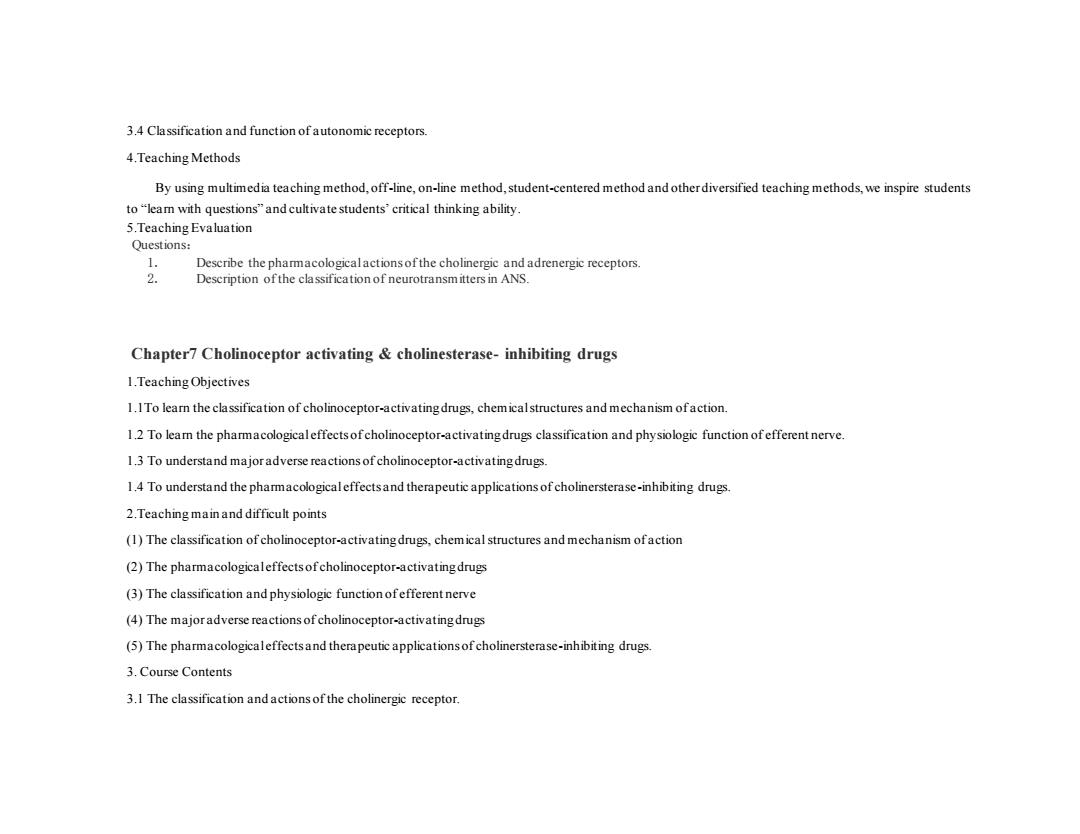
3.4 Classification and function of autonomic receptors. 4.Teaching Methods By using multimedia teaching method,off-line,on-line method,student-centered method and other diversified teaching methods,we inspire students to"leam with questions"and cultivate students'critical thinking ability. 5.Teaching Evaluation Questions: 1. Describe the pharmacologicalactions ofthe cholinergic and adrenergic receptors. 2. Description ofthe classification of neurotransmitters in ANS. Chapter7 Cholinoceptor activating cholinesterase-inhibiting drugs 1.Teaching Objectives 1.ITo learn the classification of cholinoceptor-activatingdrugs,chemicalstructures and mechanism ofaction. 1.2 To leam the pharmacologicaleffects ofcholinoceptor-activatingdrugs classification and physiologic function of efferent nerve. 1.3 To understand major adverse reactions of cholinoceptor-activatingdrugs. 1.4 To understand the pharmacological effectsand therapeutic applications of cholinersterase-inhibiting drugs. 2.Teaching main and difficult points (1)The classification of cholinoceptor-activatingdrugs,chemical structures and mechanism ofaction (2)The pharmacologicaleffects of cholinoceptor-activatingdrugs (3)The classification and physiologic function ofefferent nerve (4)The major adverse reactions of cholinoceptor-activatingdrugs (5)The pharmacologicaleffects and therapeutic applications of cholinersterase-inhibiting drugs. 3.Course Contents 3.1 The classification and actions of the cholinergic receptor
3.4 Classification and function of autonomic receptors. 4.Teaching Methods By using multimedia teaching method, off-line, on-line method, student-centered method and other diversified teaching methods, we inspire students to “learn with questions” and cultivate students’ critical thinking ability. 5.Teaching Evaluation Questions: 1. Describe the pharmacological actions of the cholinergic and adrenergic receptors. 2. Description of the classification of neurotransmitters in ANS. Chapter7 Cholinoceptor activating & cholinesterase- inhibiting drugs 1.Teaching Objectives 1.1To learn the classification of cholinoceptor-activating drugs, chemical structures and mechanism of action. 1.2 To learn the pharmacological effects of cholinoceptor-activating drugs classification and physiologic function of efferent nerve. 1.3 To understand major adverse reactions of cholinoceptor-activating drugs. 1.4 To understand the pharmacological effects and therapeutic applications of cholinersterase -inhibiting drugs. 2.Teaching main and difficult points (1) The classification of cholinoceptor-activating drugs, chemical structures and mechanism of action (2) The pharmacological effects of cholinoceptor-activating drugs (3) The classification and physiologic function of efferent nerve (4) The major adverse reactions of cholinoceptor-activating drugs (5) The pharmacological effects and therapeutic applications of cholinersterase-inhibiting drugs. 3. Course Contents 3.1 The classification and actions of the cholinergic receptor
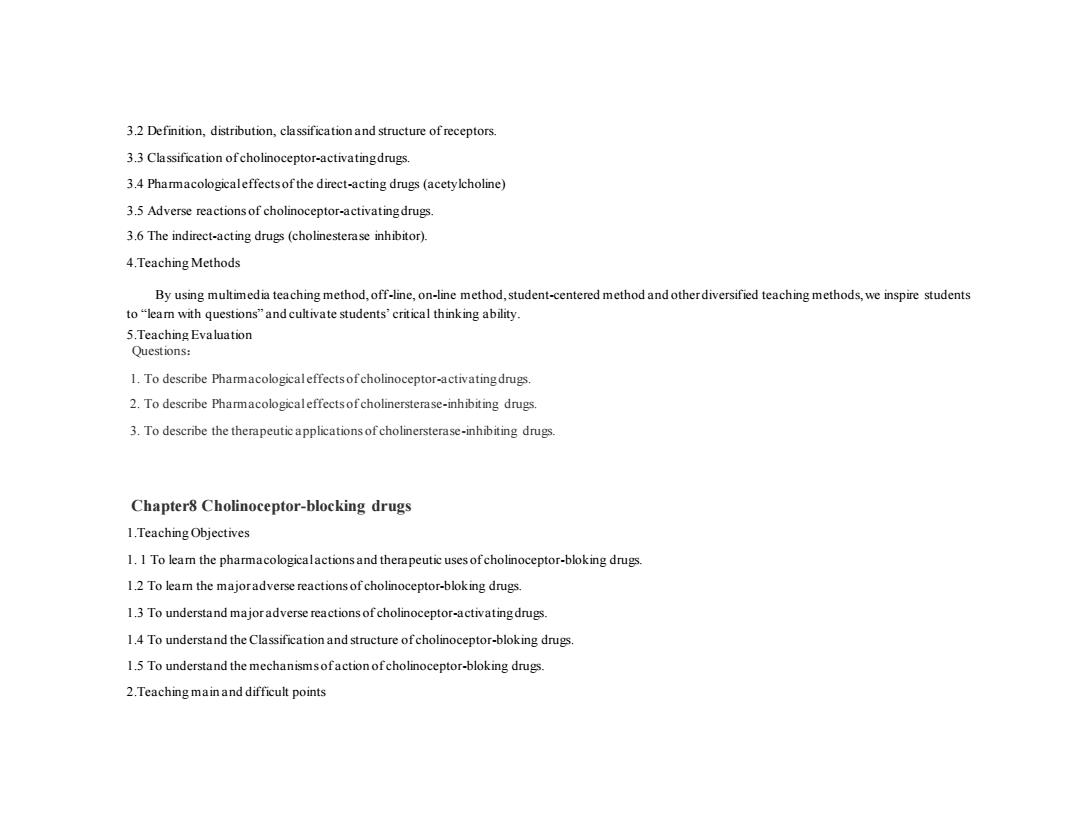
3.2 Definition,distribution,classification and structure of receptors. 3.3 Classification of cholinoceptor-activatingdrugs 3.4 Pharmacologicaleffectsof the direct-acting drugs(acetylcholine) 3.5 Adverse reactions of cholinoceptor-activatingdrugs. 3.6 The indirect-acting drugs(cholinesterase inhibitor). 4.Teaching Methods By using multimedia teaching method,off-line,on-line method,student-centered method and otherdiversified teaching methods,we inspire students to"leam with questions"and cultivate students'critical thinking ability. 5.Teaching Evaluation Questions: 1.To describe Pharmacologicaleffects of cholinoceptor-activatingdrugs. 2.To describe Pharmacological effects of cholinersterase-inhibiting drugs. 3.To describe the therapeutic applications ofcholinersterase-inhibiting drugs. Chapter8 Cholinoceptor-blocking drugs 1.Teaching Objectives 1.I To leam the pharmacologicalactionsand therapeutic uses of cholinoceptor-bloking drugs. 1.2 To leam the majoradverse reactions of cholinoceptor-bloking drugs. 1.3 To understand major adverse reactions of cholinoceptor-activatingdrugs. 1.4 To understand the Classification and structure ofcholinoceptor-bloking drugs. 1.5 To understand the mechanismsofaction ofcholinoceptor-bloking drugs. 2.Teaching main and difficult points
3.2 Definition, distribution, classification and structure of receptors. 3.3 Classification of cholinoceptor-activating drugs. 3.4 Pharmacological effects of the direct-acting drugs (acetylcholine) 3.5 Adverse reactions of cholinoceptor-activating drugs. 3.6 The indirect-acting drugs (cholinesterase inhibitor). 4.Teaching Methods By using multimedia teaching method, off-line, on-line method, student-centered method and other diversified teaching methods, we inspire students to “learn with questions” and cultivate students’ critical thinking ability. 5.Teaching Evaluation Questions: 1. To describe Pharmacological effects of cholinoceptor-activating drugs. 2. To describe Pharmacological effects of cholinersterase-inhibiting drugs. 3. To describe the therapeutic applications of cholinersterase-inhibiting drugs. Chapter8 Cholinoceptor-blocking drugs 1.Teaching Objectives 1. 1 To learn the pharmacological actions and therapeutic uses of cholinoceptor-bloking drugs. 1.2 To learn the major adverse reactions of cholinoceptor-bloking drugs. 1.3 To understand major adverse reactions of cholinoceptor-activating drugs. 1.4 To understand the Classification and structure of cholinoceptor-bloking drugs. 1.5 To understand the mechanisms of action of cholinoceptor-bloking drugs. 2.Teaching main and difficult points
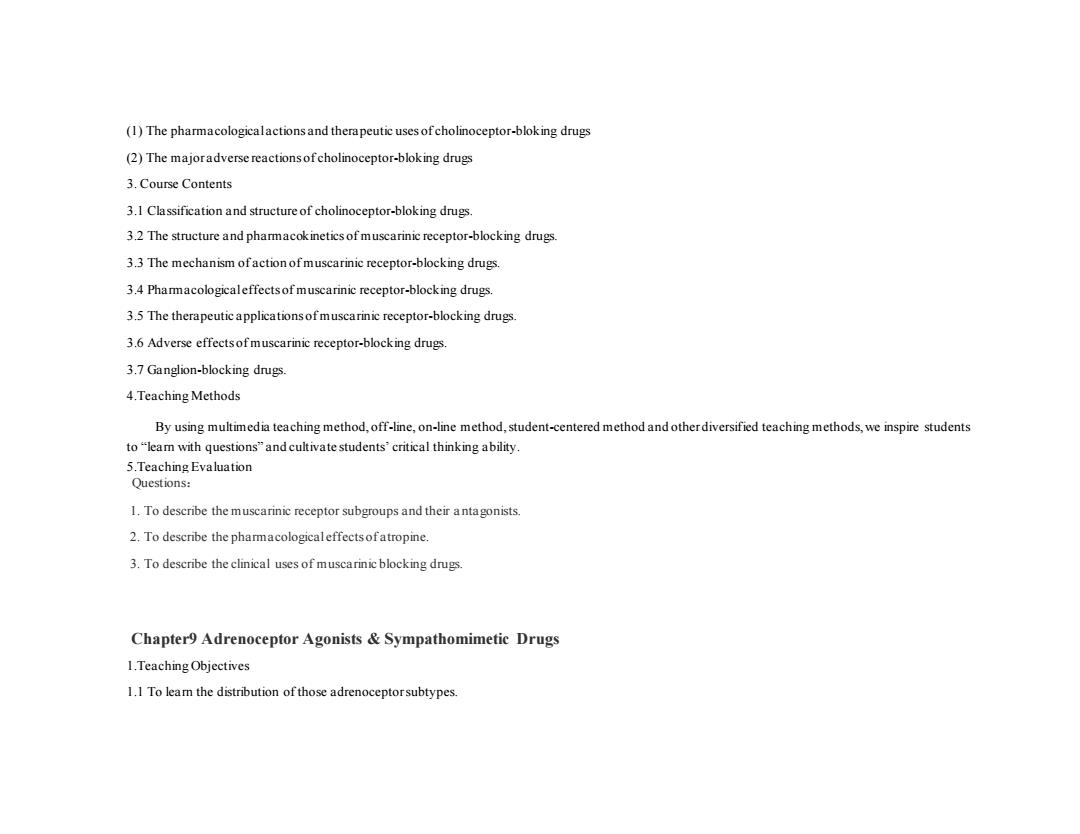
(1)The pharmacologicalactions and therapeutic uses of cholinoceptor-bloking drugs (2)The majoradverse reactions of cholinoceptor-bloking drugs 3.Course Contents 3.1 Classification and structure of cholinoceptor-bloking drugs. 3.2 The structure and pharmacokinetics of muscarinic receptor-blocking drugs. 3.3 The mechanism ofaction of muscarinic receptor-blocking drugs 3.4 Pharmacologicaleffects of muscarinic receptor-blocking drugs. 3.5 The therapeutic applications of muscarinic receptor-blocking drugs. 3.6 Adverse effectsofmuscarinic receptor-blocking drugs. 3.7 Ganglion-blocking drugs. 4.Teaching Methods By using multimedia teaching method,off-line,on-line method,student-centered method and otherdiversified teaching methods,we inspire students to"leam with questions"and cultivate students'critical thinking ability. 5.Teaching Evaluation Questions: 1.To describe the muscarinic receptor subgroups and their antagonists. 2.To describe the pharmacologicaleffectsofatropine. 3.To describe the clinical uses of muscarinic blocking drugs. Chapter9 Adrenoceptor Agonists Sympathomimetic Drugs 1.Teaching Objectives 1.1 To learn the distribution of those adrenoceptorsubtypes
(1) The pharmacological actions and therapeutic uses of cholinoceptor-bloking drugs (2) The major adverse reactions of cholinoceptor-bloking drugs 3. Course Contents 3.1 Classification and structure of cholinoceptor-bloking drugs. 3.2 The structure and pharmacokinetics of muscarinic receptor-blocking drugs. 3.3 The mechanism of action of muscarinic receptor-blocking drugs. 3.4 Pharmacological effects of muscarinic receptor-blocking drugs. 3.5 The therapeutic applications of muscarinic receptor-blocking drugs. 3.6 Adverse effects of muscarinic receptor-blocking drugs. 3.7 Ganglion-blocking drugs. 4.Teaching Methods By using multimedia teaching method, off-line, on-line method, student-centered method and other diversified teaching methods, we inspire students to “learn with questions” and cultivate students’ critical thinking ability. 5.Teaching Evaluation Questions: 1. To describe the muscarinic receptor subgroups and their a ntagonists. 2. To describe the pharmacological effects of atropine. 3. To describe the clinical uses of muscarinic blocking drugs. Chapter9 Adrenoceptor Agonists & Sympathomimetic Drugs 1.Teaching Objectives 1.1 To learn the distribution of those adrenoceptor subtypes